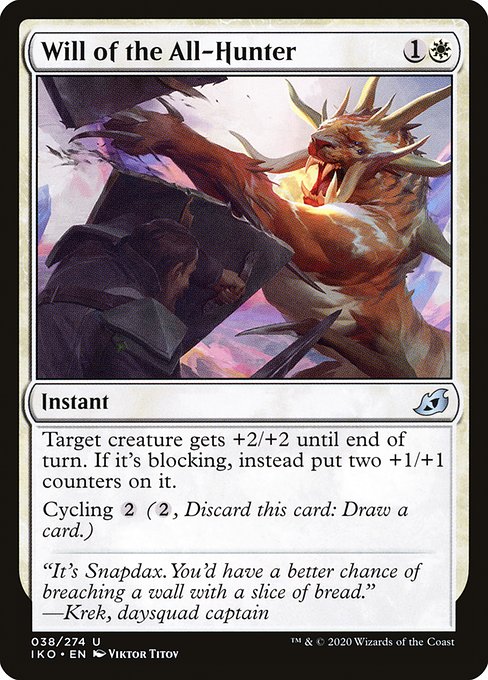
Image courtesy of Scryfall.com
Bridging Physical and Digital MTG Design: Will of the All-Hunter as a Case Study
If there’s a card that embodies the dance between cardboard and code, it’s Will of the All-Hunter. A white instant from Ikoria: Lair of Behemoths, this {1}{W} spell is deceptively compact in its text yet ambitious in its implications for cross-format design. In the physical world, you simply resolve the spell: a creature becomes bigger for a moment, or if it’s engaged in combat, you bolt on two +1/+1 counters. In the digital realm, however, you gain the opportunity to visualize two distinct outcomes with crisp, responsive feedback—one for non-blocking moments and another for blocks—while simultaneously offering a cycling option that funnels into card draw. That layered duality is a designer’s dream and a gameplay translator’s challenge. 🧙♂️🔥
Text that translates across realities
Will of the All-Hunter costs a modest {1}{W} and resolves as an instant, granting +2/+2 to the target creature until end of turn. If that creature is blocking, the effect pivots: two +1/+1 counters go onto it instead. The cycling ability—{2}, Discard this card: Draw a card—adds another axis to the card’s identity. On paper, it creates a powerful tempo swing when you’re not in combat, and a meaningful, affordable combat trick when you are. In digital, you can push this clarity further: color-coded flashes, counters animating onto a creature, and a separate cycling animation that cues a new draw. The design impulse is to preserve the math while elevating the user experience through feedback loops that feel natural in both modalities. ⚔️🎨
“It’s Snapdax. You’d have a better chance of breaching a wall with a slice of bread.” —Krek, daysquad captain
The flavor text anchors Ikoria’s wild, monster-filled world while reminding players that even in a moment of tactical frenzy, wit and timing win battles. The card’s typeline—Instant—keeps it fast and accessible in both formats, and its color identity (white) aligns with the era’s emphasis on efficient, value-driven plays. Will of the All-Hunter isn’t just a spell; it’s a design blueprint for how a single card can function as a bridge between tabletop tactility and digital immediacy. 🧙♂️💎
Design patterns that travel well from paper to screen
Ikoria’s set design embraces audacious synergy and modular combat math, and Will of the All-Hunter sits at that crossroads. A few takeaways for cross-format design stand out:
- Conditional outcomes that stay legible: The “+2/+2 until end of turn” vs “two +1/+1 counters if blocking” split is a perfect test case for how a card can play differently depending on game state. In digital interfaces, conveying these two modes with distinct visual states helps players instantly grasp the stakes of combat without rereading the card. In physical play, players rely on memory and timing; the text makes the decision explicit. 🧭
- Cycling as a bridge to recursion: The cycling ability gives players agency to transform a less-than-ideal draw into tempo, card advantage, or late-game gas. Digitally, cycling can present a neat, tangible draw animation, while on the table you still feel the tug of “let me draw something usable.” The duality mirrors MTG’s broader push toward dynamic gameplay across formats. 🔄
- Color and cadence: White mana often emphasizes efficiency and value—Will of the All-Hunter embodies that with a low mana cost and a flexible effect. The card’s presence in Ikoria, a set known for its cinematic mechanics and monster mash, demonstrates how colorless or color-coded design cues can be reinforced differently in digital clients (animations, hover hints, quick previews) versus on a card—ensuring consistency without sacrificing personality. 🎨
- Rarity and accessibility: As an uncommon, the card sits in the sweet spot of playability and discovery. Digital platforms can showcase its utility through curated decks or suggested upgrades, while physical play emphasizes collectability and tangible value. The art, by Viktor Titov, and the card’s sleek silhouette help it stand out in both spaces. 🔥
From a collector’s lens, Will of the All-Hunter presents an interesting case: a common sense of urgency in combat combined with a cycling engine that invites exploration. In digital ecosystems, you can highlight the cycling draw synergy with subtle cues—glow effects and a separate UI track for cycling—without muddying the core resolution. In the real world, players savor the subtle drama of the counters on a blocking creature, and the card’s uncommon status often makes it a sought-after addition to Ikoria-themed decks. ⚔️
When physical form meets digital function
The crux of cross-format design lies in maintaining fidelity to the card’s core identity while leveraging the strengths of each medium. Will of the All-Hunter demonstrates how a well-structured spell can feel equally meaningful in a sealed league and in an Arena ladder match. The instant-speed interaction remains accessible, the cycling option remains a strategic choice, and the conditional outcome on blocks preserves a spicy edge that rewards attentive play. For designers, the lesson is clear: preserve the core math, elevate the feedback, and give players a reason to say, “I want to play that again”—whether they’re holding a physical card or tapping a digital deck. 🧙♂️🔥
If you’re strolling the table or scrolling the interface, you might find that a little thoughtful physical-digital cross-pollination goes a long way. It’s the same game, just two brilliant ways to experience it. And if you’re looking to bring a splash of MTG flair to your everyday carry, consider a stylish way to showcase your collection—like the Neon Card Holder Phone Case MagSafe Polycarbonate—so your cards stay as sharp as your strategy.
Neon Card Holder Phone Case MagSafe Polycarbonate
More from our network
- https://blog.digital-vault.xyz/blog/post/placing-into-the-night-on-mtgs-timeline/
- https://blog.zero-static.xyz/blog/post/prosperous-innkeeper-long-term-value-in-mtg-finance/
- https://crypto-acolytes.xyz/blog/post/how-dopamine-fuels-the-thrill-of-gaming-achievements/
- https://crypto-acolytes.xyz/blog/post/ultimate-guide-to-the-best-game-boy-advance-rpgs/
- https://blog.digital-vault.xyz/blog/post/subscription-models-vs-one-time-payments-what-works-best/